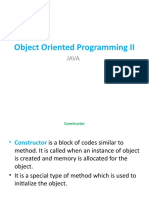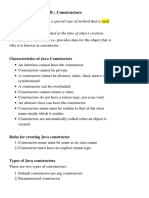0% found this document useful (0 votes)
7 views5 pagesJava Oop Detailed Constructor
A constructor in Java is a special method that initializes objects and shares the same name as the class without a return type. There are three types of constructors: default, parameterized, and copy constructors, which can be overloaded for flexibility. Best practices include proper field initialization, avoiding complex logic, and using constructor chaining for efficiency.
Uploaded by
clanclasher.th4Copyright
© © All Rights Reserved
We take content rights seriously. If you suspect this is your content, claim it here.
Available Formats
Download as PDF, TXT or read online on Scribd
0% found this document useful (0 votes)
7 views5 pagesJava Oop Detailed Constructor
A constructor in Java is a special method that initializes objects and shares the same name as the class without a return type. There are three types of constructors: default, parameterized, and copy constructors, which can be overloaded for flexibility. Best practices include proper field initialization, avoiding complex logic, and using constructor chaining for efficiency.
Uploaded by
clanclasher.th4Copyright
© © All Rights Reserved
We take content rights seriously. If you suspect this is your content, claim it here.
Available Formats
Download as PDF, TXT or read online on Scribd
/ 5


























































































